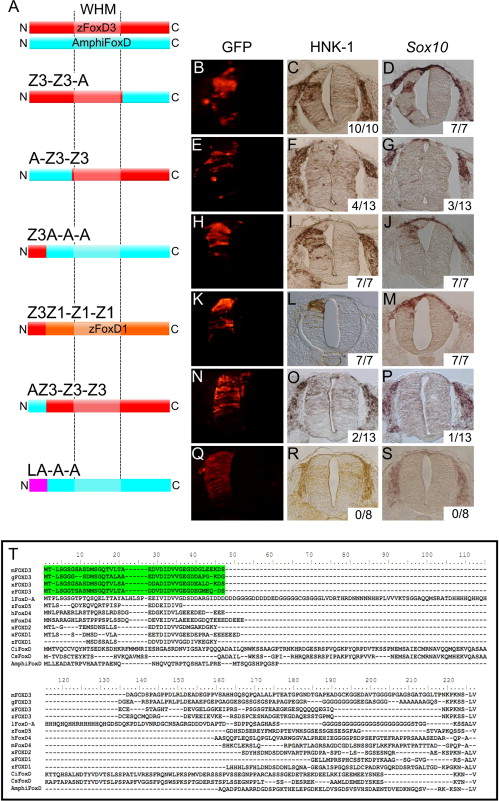Fig. 3
Effect of overexpression of chimeric FoxD proteins on Sox10 and HNK-1 epitope expression in chick neural tube. (A) Schematic illustrations of chimeric protein constructs, where amino acid segments from zFoxD3, AmphiFoxD, zFoxD1 and lamprey FoxD-A are shown in red, blue, orange and magenta respectively. Upregulation of the HNK-1 epitope (middle column: C, F, I, L, O, R) and Sox10 (right column: D, G, J, M, P, S) were induced by chimeric constructs: Z3-Z3-A, Z3A-A-A and Z3Z1-Z1-Z1, but only fairly induced by A-Z3-Z3, AZ3-Z3-Z3 or LA-A-A. Transfected cells were visualized by anti-GFP antibody in adjacent sections of embryos in which GFP-pCAGGS were co-electroporated (left column: B, E, H, K. N, Q). Ectopic expression of the FoxD proteins was induced on the left-hand side of the neural tube. Numbers in the panel show the number of embryos in which marker overexpression was observed as a fraction of the number of embryos examined. (T) Amino acid sequence alignment of the N-terminal portions of proteins encoded by genes of the FoxD family. The 39-aa N-terminal segment conserved in FoxD3 genes is shaded green.
Reprinted from Developmental Biology, 385(2), Ono, H., Kozmik, Z., Yu, J.K., and Wada, H., A novel N-terminal motif is responsible for the evolution of neural crest-specific gene-regulatory activity in vertebrate FoxD3, 396-404, Copyright (2014) with permission from Elsevier. Full text @ Dev. Biol.

